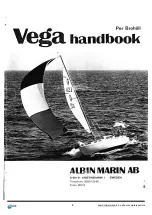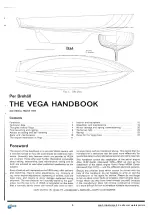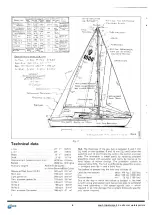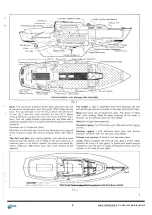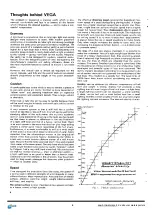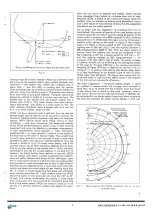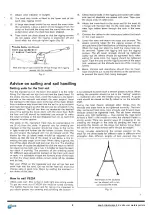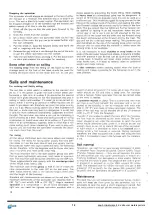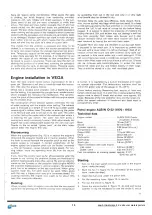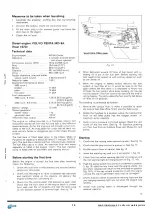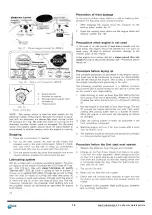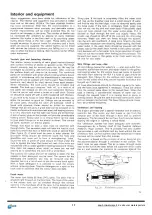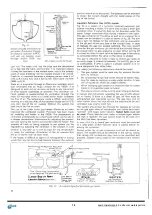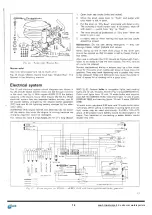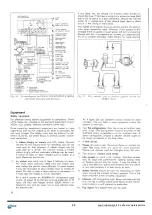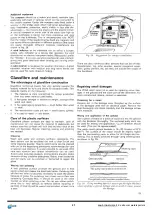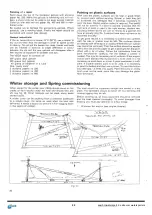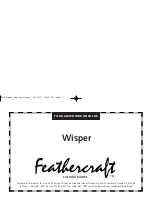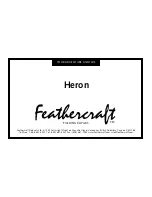
11. A t t a c h wind indicator or burgee.
12. The back stay b r i d l e is fixed t o the lower end of the
back stay rigging screw.
13. A large rope s t r o p should be put round the mast under
the spreaders. Leave a piece of line hanging from the
s t r o p so that both the strop and the crane hook can be
pulled down w h e n the mast has been s t e p p e d .
14. Tape round the chain plates so that t h e rigging s c r e w s
d o not topple w h e n the rigging is slackened off and
b e n d when the s h r o u d s tighten again (fig. 9).
ÖOWN AND CAW R 6 6 e . » T
IF SHROU6 F i a H T E N b
\ ,
'J—'Uit/ - - -
j ^ U
With the help of tape around the shroud fittings bent rigging
screws can be avoided.
Fig.
9
15. C h e c k that all bolts in the rigging are l o c k e d w i t h c o t t e r
pins and all shackles are siezed w i t h w i r e . Tape o v e r
the sharp ends of c o t t e r pins.
16. A t t a c h the crane h o o k to the strop and lift the mast till
it hangs with the f o o t near the the mast step. Feed t h e
mast light cables d o w n through the hole in the mast
step.
17. C o n n e c t the cables t o the c o n n e c t o r s behind the hatch
on the mast support.
18. Lower the mast and attach the stays and shrouds. The
plastic covering tubes for the rigging screws of t h e
shrouds have to be f i t t e d before c o n n e c t i n g the s h r o u d s .
W h e n the mast can stand by itself the crane hook can
be r e m o v e d . Tighten the rigging and lock the rigging
s c r e w s . The aft l o w e r shrouds s h o u l d be t i g h t e n e d
lightly but the others should be t i g h t e n e d hard. A f t e r
sailing f o r some time, the rigging s h o u l d be t i g h t e n e d
again. Tape the pins and the rigging s c r e w s of the stays
(not .lecessary on the shrouds becai se of the c o v e r i n g
tubes).
19. B o o m , lifelines and stanchions should then be f i x e d .
Tape should be put round the lifelines at the stanchions
to p r e v e n t the c o v e r f r o m being d a m a g e d .
Advice on sailing and sail handling
Setting sails for the first sail
Pull the mainsail out on the boom and attach it to the roller
f i t t i n g . Pull the sail out tight but not past the black band. Fit
the slides into the mast track, insert t h e battens in the batten
p o c k e t s in the mainsail and attach t h e main halyard. Hoist
the mainsail to the black band at the top of the mast. C h e c k
f r o m a distance w i t h binoculars that t h e sail is up to the band
and mark the halyard so that the sail can be rehoisted in the
same p o s i t i o n . The luff can then be t e n s i o n e d the desired
amount b y pulling the boom down w i t h the down haul. Both
the foot and luff s h o u l d be stretched just enough to make
the small wrinkles in the sail disappear but not so hard that
diagonal w r i n k l e s appear.
The s t o p s on the mainsheet track may be placed about 15
cm (6 in) from the e n d s . A general rule for sheeting the
mainsail is that the t r a v e l l e r should be close to the centre
in light w i n d s and f u r t h e r out the harder it blows. Hoist the
jib and tension the halyard with the j i b halyard w i n c h . The
b l o c k s f o r the jib sheet leads should be adjusted on the
t r a c k s so that the line of the sheet is just below a line b i -
secting the sails angle at the tack. W h e n using a genoa, the
line of the sheet should lead just over this line. The sheeting
points must of course be adjusted so that the leech is neither
t o o slack nor too tight. A s a rule, it is better to have the leech
t o o slack if anything. The positions of the sheeting points
f o r different sails should be marked on the track w i t h paint
or tape. It is advisable to tape the f o r w a r d ends of the track
so that the sheet block slides cannot come off by mistake
and be lost.
Sail y o u r VEGA on t h e headsails and she will go fast and
point high into the w i n d . D o not let her heel too much but
change sails in g o o d time. Begin by reefing the mainsail —
but more of this later.
How to sail VEGA
V E G A sails well. She is fast in both light ans strong w i n d s .
To get the most out of V E G A she must be tuned correctly.
The b o t t o m has to be clean and for racing it is important to
put e l b o w grease into painting and p o l i s h i n g the b o t t o m —
it is a pleasure to polish such a smooth plastic surface. W h e n
sailing, the propeller s h o u l d be put in the " s a i l i n g " p o s i t i o n
— feathered and with the blades lying vertically. A g u i d e
mark should be placed on the fly wheel or on the p r o p e l l e r
shaft.
Tuning the boat means, amongst other things, that the
shrouds and stays have to be tightened correctly. The f o r e -
stay, p e r m a n e n t back stay, main shrouds and f o r w a r d l o w e r
shrouds s h o u l d be t i g h t e n e d hard. The aft lower s h r o u d s
require only light t i g h t e n i n g — thus making the mast bend
f o r w a r d a little in the middle to make the mainsail flatter in
strong w i n d s . There are several ways of increasing or d e -
creasing the draught in the sails by bending the mast or
adjusting the tension on the stays, but b e f o r e trying t h e s e
the advice of an experienced sailor should be sought.
Tuning includes ascertaining the correct position on the
track for the sheet leads f o r different sails in different w i n d
strengths. A l s o different lengths of tack pennant may be
The tension in the backstay
can be altered with a lan-
yard around the bridle.
Fig. 10
9


